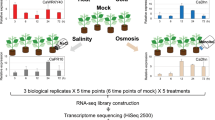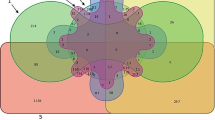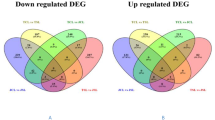Abstract
Heat stress is an important agricultural problem around the world. In pepper (Capsicum annum L.), heat stress seriously affects pollination and yield. However, to date, the molecular basis of heat stress has not been extensively studied. Using the HiSeq™ 2000 sequencing platform, the seedling transcriptome of heat-susceptible C.annuum ‘S590’(CaS) and heat-tolerant ‘R597’ (CaR) under the heat stress was examined. Over five million clean reads were generated from each library, each corresponding to a coverage of >250,000 nt. About 73% of the reads were mapped to the pepper genome, and 3,799 and 4,010 differentially expressed genes (DEGs) were identified in ‘R597’ (CaR) and ‘S590’(CaS), respectively. Gene ontology (GO) and Kyoto Encyclopedia of Genes and Genomes (KEGG) analyses determined that the identified DEGs were involved in heat shock protein, heat shock transcription factors, hormone, as well as calcium and kinase signaling. Further validation identified 35 genes that were involved in stress response, and that most of the heat shock proteins were upregulated in two genotypes, and highly expressed in susceptible S590 than in tolerant cultivar R597; the transcription factors and hormone signaling genes showed higher levels of expression in the heat-tolerant cultivar R597 than that observed in the heat-susceptible S590. These findings facilitate in better understanding of the molecular mechanism underlying heat stress in different pepper genotypes.
Similar content being viewed by others
References
Bindea G, Mlecnik B, Hackl H, Charoentong P, Tosolini M, Kirilovsky A, Fridman WH, Pages F, Trajanoski Z, Galon J (2009) ClueGO: a Cytoscape plug-in to decipher functionally grouped gene ontology and pathway annotation networks. Bioinformatics 25:1091–1093
Busch W, Wunderlich M, Schöffl F (2005) Identification of novel heat shock factor-dependent genes and biochemical pathways in Arabidopsis thaliana. Plant J 41:1–14
Campos PS, nia Quartin V, chicho Ramalho J, Nunes MA (2003) Electrolyte leakage and lipid degradation account for cold sensitivity in leaves of Coffea sp. plants. J Plant Physiol 160:283–292
Chauhan H, Khurana N, Tyagi AK, Khurana JP, Khurana P (2011) Identification and characterization of high temperature stress responsive genes in bread wheat (Triticum aestivum L.) and their regulation at various stages of development. Plant Mol Biol 75:35–51
Chen Z, Cuin TA, Zhou M, Twomey A, Naidu BP, Shabala S (2007) Compatible solute accumulation and stress-mitigating effects in barley genotypes contrasting in their salt tolerance. J Exp Bot 58:4245–4255
Conesa A, Gotz S (2008) Blast2GO: A comprehensive suite for functional analysis in plant genomics. Int J Plant Genomics 2008:619832
Erickson AN, Markhart AH (2002) Flower developmental stage and organ sensitivity of bell pepper (Capsicum annuum L.) to elevated temperature. Plant Cell Environ 25:123–130
Frank G, Pressman E, Ophir R, Althan L, Shaked R, Freedman M, Shen S, Firon N (2009) Transcriptional profiling of maturing tomato (Solanum lycopersicum L.) microspores reveals the involvement of heat shock proteins, ROS scavengers, hormones, and sugars in the heat stress response. J Exp Bot 60:3891–3908
Fukao T, Xu K, Ronald PC, Bailey-Serres J (2006) A variable cluster of ethylene response factor-like genes regulates metabolic and developmental acclimation responses to submergence in rice. Plant Cell 18:2021–2034
Gajanayake B, Trader BW, Reddy KR, Harkess RL (2011) Screening Ornamental Pepper Cultivars for Temperature Tolerance Using Pollen and Physiological Parameters. Hort Sci 46:878–884
Gilroy S, Suzuki N, Miller G, Choi W-G, Toyota M, Devireddy AR, Mittler R (2014) A tidal wave of signals: calcium and ROS at the forefront of rapid systemic signaling. Trends Plant Sci 19:623–630
Gongora-Castillo E, Ibarra-Laclette E, Trejo-Saavedra DL, Rivera-Bustamante RF (2012) Transcriptome analysis of symptomatic and recovered leaves of geminivirus-infected pepper (Capsicum annuum). Virol J 9:295
González-Zamora A, Sierra-Campos E, Luna-Ortega JG, Pérez-Morales R, Ortiz JCR, García-Hernández JL (2013) Characterization of different (Capsicum) varieties by evaluation of their capsaicinoids content by high performance liquid chromatography, determination of pungency and effect of high temperature. Molecules 18:13471–13486
Guo M, Yin YX, Ji JJ, Ma BP, Lu MH, Gong ZH (2014) Cloning and expression analysis of heat-shock transcription factor gene CaHsfA2 from pepper (Capsicum annuum L.). Genet Mol Res 13:1865–1875
Hasanuzzaman M, Nahar K, Alam MM, Roychowdhury R, Fujita M (2013) Physiological, biochemical, and molecular mechanisms of heat stress tolerance in plants. Int J Mol Sci 14:9643–9684
Hays DB, Do JH, Mason RE, Morgan G, Finlayson SA (2007) Heat stress induced ethylene production in developing wheat grains induces kernel abortion and increased maturation in a susceptible cultivar. Plant Sci 172:1113–1123
Hedhly A, Hormaza JI, Herrero M (2009) Global warming and sexual plant reproduction. Trends Plant Sci 14:30–36
Jung K-H, Ko H-J, Nguyen M, Kim S-R, Ronald P, An G (2012) Genome-wide identification and analysis of early heat stress responsive genes in rice. J Plant Biol 55:458–468
Kafizadeh N, Carapetian J, Kalantari KM (2008) Effects of heat stress on pollen viability and pollen tube growth in pepper. Res J Biol Sci 3:1159–1162
Kim S, Park M, Yeom SI, Kim YM, Lee JM, Lee HA, Seo E, Choi J, Cheong K, Kim KT, Jung K, Lee GW, Oh SK, Bae C, Kim SB, Lee HY, Kim SY, Kim MS, Kang BC, Jo YD, et al. (2014) Genome sequence of the hot pepper provides insights into the evolution of pungency in Capsicum species. Nat Genet 46:270–278
Kotak S, Larkindale J, Lee U, von Koskull-Doring P, Vierling E, Scharf KD (2007) Complexity of the heat stress response in plants. Curr Opin Plant Biol 10:310–316
Larkindale J, Hall JD, Knight MR, Vierling E (2005) Heat Stress Phenotypes of Arabidopsis Mutants Implicate Multiple Signaling Pathways in the Acquisition of Thermotolerance. Plant Physiol 138:882–897
Larkindale J, Huang B (2004) Thermotolerance and antioxidant systems in Agrostis stolonifera: involvement of salicylic acid, abscisic acid, calcium, hydrogen peroxide, and ethylene. J Plant Physiol 161:405–413
Lee S, Choi D (2013) Comparative transcriptome analysis of pepper (Capsicum annuum) revealed common regulons in multiple stress conditions and hormone treatments. Plant Cell Rep 32:1351–1359
Lee S, Yun SC (2006) The ozone stress transcriptome of pepper (Capsicum annuum L.). Mol Cells 21:197–205
Li W, Cheng J, Wu Z, Qin C, Tan S, Tang X, Cui J, Zhang L, Hu K (2015) An InDel-based linkage map of hot pepper (Capsicum annuum). Mol Breeding 35:1–10
Liu C, Ma N, Wang PY, Fu N, Shen HL (2013) Transcriptome sequencing and de novo analysis of a cytoplasmic male sterile line and its near-isogenic restorer line in chili pepper (Capsicum annuum L.). PLoS One 8:e65209
Liu F, Wang W, Sun X, Liang Z, Wang F (2014) RNA-Seq revealed complex response to heat stress on transcriptomic level in Saccharina japonica (Laminariales, Phaeophyta). J Appl Phycol 26:1585–1596
Liu GT, Wang JF, Cramer G, Dai ZW, Duan W, Xu HG, Wu BH, Fan PG, Wang LJ, Li SH (2012) Transcriptomic analysis of grape (Vitis vinifera L.) leaves during and after recovery from heat stress. BMC Plant Biol 12:174
Liu H-T, Liu Y-Y, Pan Q-H, Yang H-R, Zhan J-C, Huang W-D (2006) Novel interrelationship between salicylic acid, abscisic acid, and PIP2-specific phospholipase C in heat acclimation-induced thermotolerance in pea leaves. J Exp Bot 57:3337–3347
Liu HT, Li GL, Chang H, Sun DY, Zhou RG, Li B (2007) Calmodulinbinding protein phosphatase PP7 is involved in thermotolerance in Arabidopsis. Plant Cell Environ 30:156–164
Liu S, Chen C, Chen G, Cao B, Chen Q, Lei J (2012) RNA-sequencing tag profiling of the placenta and pericarp of pungent pepper provides robust candidates contributing to capsaicinoid biosynthesis. Plant Cell Tiss Organ Cult 110:111–121
Liu S, Li W, Wu Y, Chen C, Lei J (2013) De novo transcriptome assembly in chili pepper (Capsicum frutescens) to identify genes involved in the biosynthesis of capsaicinoids. PLoS One 8:e48156
Mangelsen E, Kilian J, Harter K, Jansson C, Wanke D, Sundberg E (2011) Transcriptome analysis of high-temperature stress in developing barley caryopses: early stress responses and effects on storage compound biosynthesis. Mol Plant 4:97–115
Martinez-Lopez LA, Ochoa-Alejo N, Martinez O (2014) Dynamics of the chili pepper transcriptome during fruit development. BMC Genomics 15:143
Mateos RM, Jimenez A, Roman P, Romojaro F, Bacarizo S, Leterrier M, Gomez M, Sevilla F, Del Rio LA, Corpas FJ, Palma JM (2013) Antioxidant Systems from Pepper (Capsicum annuum L.): Involvement in the Response to Temperature Changes in Ripe Fruits. Int J Mol Sci 14:9556–9580
Mittal D, Chakrabarti S, Sarkar A, Singh A, Grover A (2009) Heat shock factor gene family in rice: genomic organization and transcript expression profiling in response to high temperature, low temperature and oxidative stresses. Plant Physiol Biochem 47:785–795
Mortazavi A, Williams BA, McCue K, Schaeffer L, Wold B (2008) Mapping and quantifying mammalian transcriptomes by RNASeq. Nat Methods 5:621–628
Mosquna A, Peterson FC, Park S-Y, Lozano-Juste J, Volkman BF, Cutler SR (2011) Potent and selective activation of abscisic acid receptors in vivo by mutational stabilization of their agonistbound conformation. Proc Natl Acad Sci USA 108:20838–20843
Oshino T, Abiko M, Saito R, Ichiishi E, Endo M, Kawagishi-Kobayashi M, Higashitani A (2007) Premature progression of anther early developmental programs accompanied by comprehensive alterations in transcription during high-temperature injury in barley plants. Mol Genet Genomics 278:31–42
Pitzschke A (2015) Modes of MAPK substrate recognition and control. Trends Plant Sci 20:49–55
Qin D, Wu H, Peng H, Yao Y, Ni Z, Li Z, Zhou C, Sun Q (2008) Heat stress-responsive transcriptome analysis in heat susceptible and tolerant wheat (Triticum aestivum L.) by using Wheat Genome Array. BMC Genomics 9:432
Qu AL, Ding YF, Jiang Q, Zhu C (2013) Molecular mechanisms of the plant heat stress response. Biochem Biophys Res Commun 432:203–207
Queitsch C, Hong S-W, Vierling E, Lindquist S (2000) Heat Shock Protein 101 Plays a Crucial Role in Thermotolerance in Arabidopsis. Plant Cell 12:479–492
Reddy AS, Ali GS, Celesnik H, Day IS (2011) Coping with stresses: roles of calcium- and calcium/calmodulin-regulated gene expression. Plant Cell 23:2010–2032
Rizhsky L, Liang H, Shuman J, Shulaev V, Davletova S, Mittler R (2004) When Defense Pathways Collide. The Response of Arabidopsis to a Combination of Drought and Heat Stress. Plant Physiol 134:1683–1696
Sangwan V, Örvar BL, Beyerly J, Hirt H, Dhindsa RS (2002) Opposite changes in membrane fluidity mimic cold and heat stress activation of distinct plant MAP kinase pathways. Plant J 31:629–638
Sinha AK, Jaggi M, Raghuram B, Tuteja N (2011) Mitogen-activated protein kinase signaling in plants under abiotic stress. Plant Signal Behav 6:196–203
Su P-H, Li H-m (2008) Arabidopsis Stromal 70-kD Heat Shock Proteins Are Essential for Plant Development and Important for Thermotolerance of Germinating Seeds. Plant Physiol 146:1231–1241
Swindell WR, Huebner M, Weber AP (2007) Transcriptional profiling of Arabidopsis heat shock proteins and transcription factors reveals extensive overlap between heat and non-heat stress response pathways. BMC Genomics 8:125
Timperio AM, Egidi MG, Zolla L (2008) Proteomics applied on plant abiotic stresses: Role of heat shock proteins (HSP). J Proteomics 71:391–411
Untergasser A, Cutcutache I, Koressaar T, Ye J, Faircloth BC, Remm M, Rozen SG (2012) Primer3—new capabilities and interfaces. Nucleic Acids Res 40:e115
Wahid A, Farooq M, Hussain I, Rasheed R, Galani S (2012) Responses and Management of Heat Stress in Plants, In Ahmad P, Prasad MNV eds, Environmental Adaptations and Stress Tolerance of Plants in the Era of Climate Change, Ed, Vol Springer New York pp 135–157
Wahid A, Gelani S, Ashraf M, Foolad MR (2007) Heat tolerance in plants: An overview. Environ Exp Bot 61:199–223
Xu H, Gao Y, Wang J (2012) Transcriptomic analysis of rice (Oryza sativa) developing embryos using the RNA-Seq technique. PLoS One 7:e30646
Xu X, Lei J, Li Y, Luo S, Wang H, Xu X, Li T (2013) Comprehensive evaluation for high temperature and humidity resistance in pepper (Capsicum annuum L.) budding. J Chin Trop Crops 9:1747–1751
Xu X, Lei J, Zhang C, Li y, Wang H, Li T, Xu X (2014) Methylationsensitive amplified polymorphism analysis of DNA methylation in hot pepper under high temperature and air humidity stress. J Nucl Agric Biol 28:1175–1180
Yamada K, Fukao Y, Hayashi M, Fukazawa M, Suzuki I, Nishimura M (2007) Cytosolic HSP90 Regulates the Heat Shock Response That Is Responsible for Heat Acclimation in Arabidopsis thaliana. J Biol Chem 282:37794–37804
Yang KA, Lim CJ, Hong JK, Park CY, Cheong YH, Chung WS, Lee KO, Lee SY, Cho MJ, Lim CO (2006) Identification of cell wall genes modified by a permissive high temperature in Chinese cabbage. Plant Sci 171:175–182
Zhang G, Chen M, Li L, Xu Z, Chen X, Guo J, Ma Y (2009) Overexpression of the soybean GmERF3 gene, an AP2/ERF type transcription factor for increased tolerances to salt, drought, and diseases in transgenic tobacco. J Exp Bot 60:3781–3796
Zhang W, Zhou RG, Gao YJ, Zheng SZ, Xu P, Zhang SQ, Sun DY (2009) Molecular and genetic evidence for the key role of AtCaM3 in heat-shock signal transduction in Arabidopsis. Plant Physiol 149:1773–1784
Author information
Authors and Affiliations
Corresponding author
Electronic supplementary material
Rights and permissions
About this article
Cite this article
Li, T., Xu, X., Li, Y. et al. Comparative transcriptome analysis reveals differential transcription in heat-susceptible and heat-tolerant pepper (Capsicum annum L.) cultivars under heat stress. J. Plant Biol. 58, 411–424 (2015). https://doi.org/10.1007/s12374-015-0423-z
Received:
Accepted:
Published:
Issue Date:
DOI: https://doi.org/10.1007/s12374-015-0423-z




